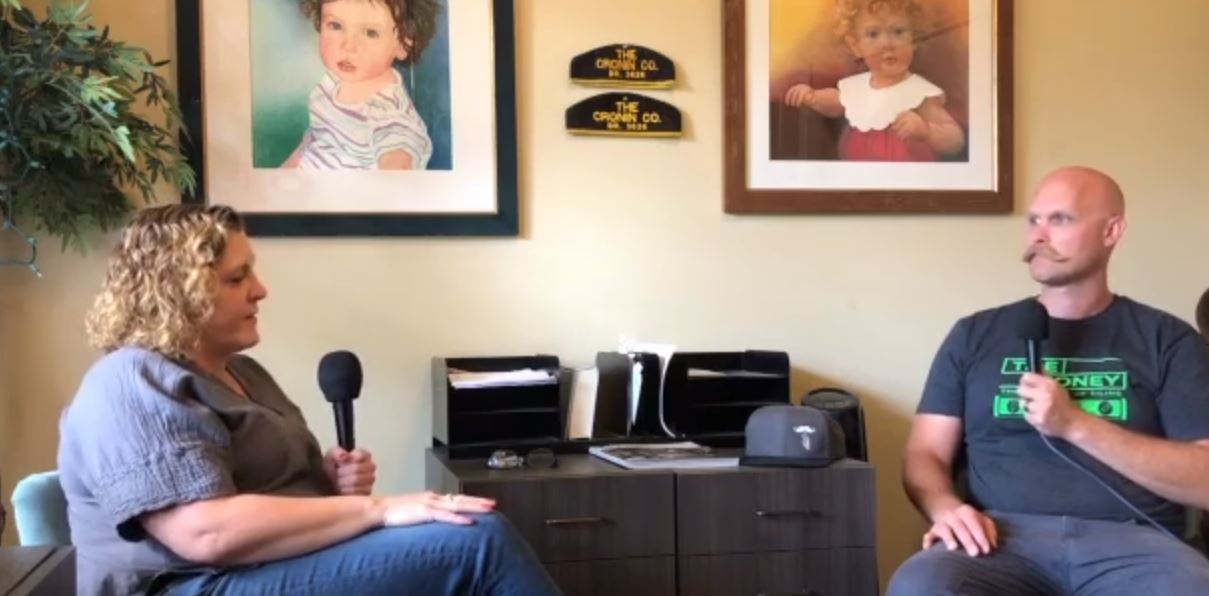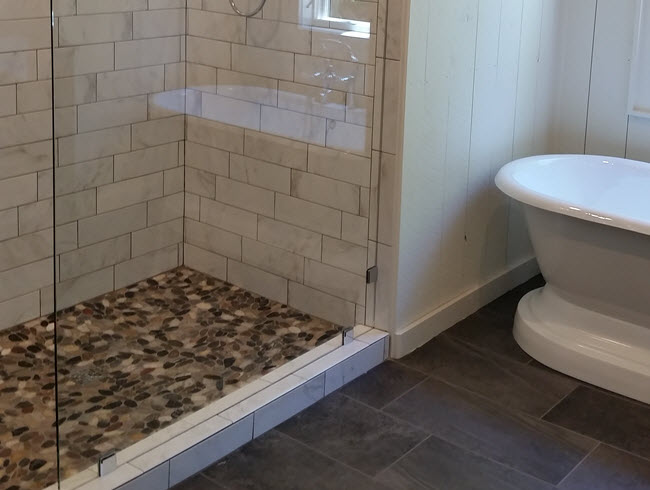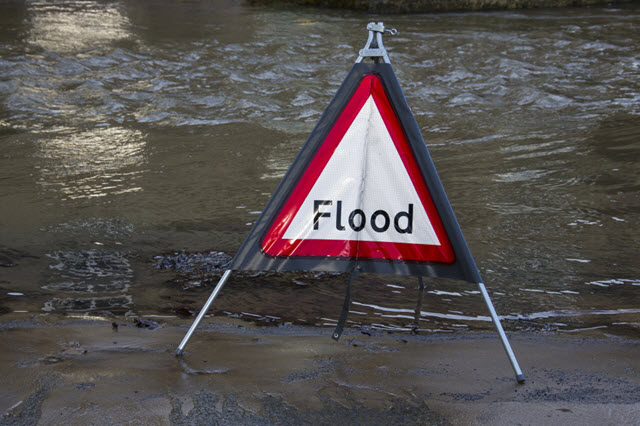Understanding Efflorescence aka that Ugly White Powder on Your Tile

We've all seen it: that really ugly white powder that grows on cement grout and also tile, stone, brick, and concrete, particularly when it's installed someplace with moisture (i.e., in a basement or outdoors). That white residue is called efflorescence.
This article goes into detail about efflorescence, including situations that readers have shared with us since the article was originally published in September 2016.
Table of Contents
Figuring Out Why Efflorescence Happens
Sometimes Efflorescence Isn't the Fault of the Tile Installation
Troubleshooting Efflorescence Situations
Spots of Efflorescence on Tile Floors
Efflorescence in a Shower Area
What About this Shower Situation?
How to Solve an Efflorescence Problem?
Can this basement situation be fixed?
If you can’t eliminate the root cause of the efflorescence, can you contain it?
Saltillo Tile and Efflorescence
Oily Efflorescence in the Kitchen
Can efflorescence on a second-floor outdoor patio be sealed?
Can a pool lead to efflorescence?
Efflorescence on Cement Roof Tile
How to Deal with Mysterious Efflorescence?
What Have You Encountered and How Have You Addressed Efflorescence?
Let’s get started.
What Causes Efflorescence?
Efflorescence for Inspectors explains that,
"Efflorescence (which means "to flower out" in French) is the dissolved salts deposited on the surface of a porous material (such as concrete or brick) that are visible after the evaporation of the water in which it was transported."
You might hear it referred to as "new building bloom" or even "whiskers."
According to the Portland Cement Association Trowel Tips information sheet of Efflorescence (downloadable PDF),
" A combination of three common circumstances causes efflorescence:
- soluble compounds (i.e., salts) in the masonry or adjoining materials
- moisture to pick up the compounds and carry them to the surface
- evaporation or hydrostatic pressure that causes the solution to move
If any one of these conditions is eliminated, efflorescence will not occur." Florescence, then, happens. As a professional tile installer, your role is to anticipate such situations to prevent them from occurring.
>> See 5 Benefits of Being a Certified Tile Installer
Figuring Out Why Efflorescence Happens
Tile installers are often called on to look at challenging installation opportunities and use their expertise to solve problems when they occur. Finding the solution can be difficult, and sometimes we scratch our heads and say, “Why is it doing that?”
Many times, installers are asked to install exterior tile on a job that appears to be elementary. Unfortunately, some of them develop issues after the tile has been installed.
Take for instance a job calling for a natural stone to be installed on the exterior wall of a new retail store that has a roof above it.
The plans call for the stone tile to be installed on a wall consisting of steel studs, a cementitious backer board, and a waterproofing membrane. It sounds routine and it should function well; which it did in this case, for about a year.
Sometimes Efflorescence Isn't the Fault of the Tile Installation
As time passed, the owner began to see a white powdery substance growing on the grout joints. Immediately the call goes out, “There is something wrong with the grout.”
Upon investigation, the grout had not failed, but a naturally occurring mineral salt which is present in all Portland cement products (thin set mortars and cement grouts) had found its way to the surface. This salt deposit is called efflorescence.
Normally, these residues can be washed away with a very mild acid solution and a bristle brush while being careful not to harm the stone (always test first to be certain the acid will not alter the existing finish). In this case, it worked… for a little while. Continued scrubbing removed the salts, but it kept coming back. What was the cause?
For efflorescence to occur on the surface as seen in the photo above, water must be present to carry the minerals to the surface, evaporate, and leave the salts behind.
You may say, “It was the rainwater going through the grout joints.”
The rain could have been the culprit, but not in this case. Remember, there was a roof over the tile.
The problem was actually caused by the roofer who failed to properly install the metal cap flashing on the parapet wall above the roof. The water went through the defective flashing, down through the thin-set mortar to the lower portion of the wall, and blossomed on the grout joints.
Once the tile installer (now a forensic specialist) found the problem, the roofer made the necessary repairs, the tile installer washed away the salt deposits, and magically the efflorescence disappeared.
Understanding Efflorescence
In this example, defective roof flashing led to excessive moisture, which in turn caused ugly white powder on the grout joints and tile.
In another situation, the problem could be the result of moisture from the soil under a basement floor or wall and might require a vapor migration membrane instead.
The important point is to find the source of the problem and solve it so efflorescence doesn't reoccur. This is what identifies a true tile installation professional.
>> See The Top Ten Requirements for a Quality Tile Installation
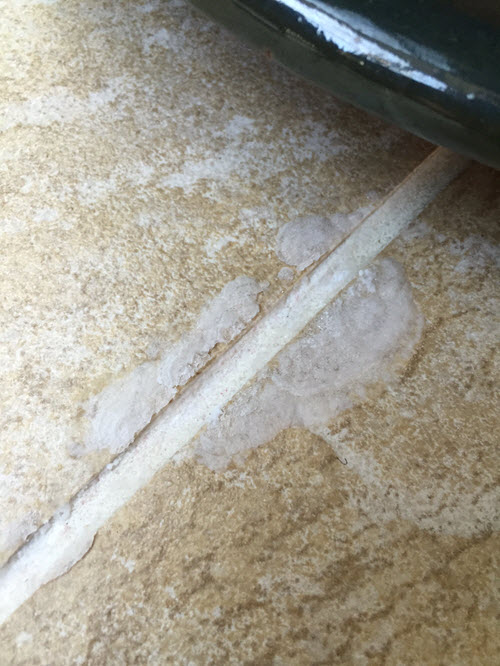
Troubleshooting Efflorescence Situations
Since publishing this article on 9/6/2016, we have received many questions about specific efflorescence scenarios.
One of the frustrations encountered when that ugly white powder occurs is that it takes detective work to determine the root cause. I have listed the situations readers have shared along with the questions to ask and/or potential solutions for each one.
New Pebble Shower Floor
"My wife and I had a new house built in Arizona and had a Pebble Shower Floor installed. The house is on a post-tension concrete slab. The house was finished at about the beginning of April 2016. We did not move in until October of 2016.
In January 2017, I noticed a dark jagged line about a 1/4-inch-wide on the pebble shower floor from the middle of the shower door opening at the top of the floor pan to the drain. A week later the line turned white. I am assuming that the white jagged line represents a crack in the grout, and the white is efflorescence.
The builder's tile subcontractor said he had never seen this before and needed to discuss this with others. The builder's subcontractor said that the rubber pan liner under the mortar bed had passed water testing and there is nothing to worry about. He said it also could be a low spot on the floor where water puddles. Sealing the grout will probably fix the problem.
When the white line gets wet it is somewhat faded but you can still see it. Low spot theory seems wrong since the rest of the floor is fine and puddles form in other areas of the floor with no white residue; in addition, the white line starts just where the pebble floor meets the perpendicular ceramic tile forming the door opening at the top of the floor pan. The rest of the floor dries fairly rapidly except for this line and at some of the junctions along the shower floor where the pebble floor meets the wall ceramic tiles."
Here are questions to ask about this situation:
- Was sloped fill (pre-slope) placed under the shower pan membrane?
- Are the weep holes in the drain body, which are an important part of this system, clogged or sealed shut?
- Was the mortar bed under the tile fractured (cracked) during the installation process?
- Does the jagged line in the pebble stone coincide with the mortar bed crack? (This can only be determined by dismantling the shower floor)
Spots of Efflorescence on Tile Floors
"I have a 46-year-old home with original tile floors. For some reason, we are seeing spots of Efflorescence in different rooms. What do I need to do to fix this, so it stops and does not recur?"
In this situation, more information would be needed to determine the cause.
However, moisture in the mortar bed or setting bed is bringing naturally occurring salts to the surface.
The question would be, what is the source of the moisture?
Is this efflorescence?
“I have clear crystal-y goo that comes up in the grout between my basement tiles. It comes up in little peaks and then hardens to a white scale. It began with spots in the middle of the living area and now I am finding more in other rooms downstairs in the grout. Is this efflorescence? and will all the tile need torn up? The tile is on a concrete floor.”
This could be efflorescence, but then, again it could be latex leeching. The difference between the two is determined by one question. Is the residue soft and powdery or hard? If it is the former, it is efflorescence. If it is the latter, it is latex from the mortar and/or the grout which has been carried by moisture to the surface. When it dries, a hard white-colored coating remains.
More information is needed to appropriately answer your questions. Is this a new or existing installation? Given the limited information provided, it is difficult to offer advice. But whichever residue is occurring on the floor, the cause is moisture coming through the concrete slab from some (at this time) unknown source. Find the source of the moisture, mitigate it the problem should disappear.
Dark Grey Grout Turns White
"I am having issues with my new grout turning white immediately after my remodel of the master bath. The dark grey is turning white and my contractor is ignoring my plea for help. I am now working with the manufacturer to come up with a solution. Their ads claim using this grout will not allow efflorescence to occur and can be used in showers. I have read many articles on this issue and have no idea what or who to believe ☹️.
What should have been a beautiful floor using light grey tile and dark grey grout is a major and expensive disappointment."
More information is needed to solve this issue, but here are a couple of questions to ask:
- Is this issue occurring on the bathroom floor, the stall shower floor, or both?
- What method was used to install the substrate (the surface just below the tile)?
One note: The grout most likely is not the source of the issue, but rather the residence of the efflorescence.
Efflorescence in a Shower Area
"We recently remodeled my parents’ bathroom to make a handicapped-accessible shower for them.
The contractor prepared the floor of the 5x7 room so that it would drain toward the shower drain. Tile was installed on the flooring two days later. Now it has hard white stuff in grout and on the tile and I don't know how to get rid of it. Painter says it's too hard to be texture or paint. Tiler is not answering phone calls or emails.
Do you think it is efflorescence? If so, it's a shower area and is going to stay wet a lot. I can send pictures."
This most likely is not efflorescence, but what is known as latex migration or leeching as shown in the photo below. The key element here is that the residue is hard. Efflorescence is normally a soft powdery material that can be brushed away.
Latex migration, which occurs similarly due to excess water in the system, most times comes from the improper mixing or cleanup of the grout or excess moisture in the setting bed beneath the tile. The dried latex can be difficult to remove. Contact the grout manufacturer for their recommendations.
When using any chemical, always test first in an inconspicuous place to determine whether a satisfactory result will be achieved and use the weakest form of the product, then work up to a stronger proportion as directed by the instructions.
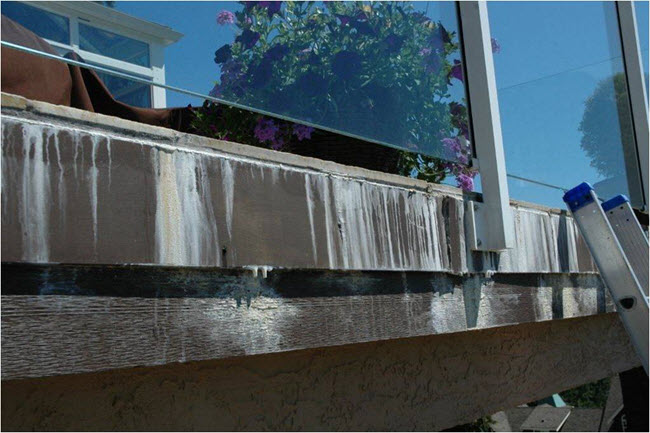
What About this Shower Situation?
“We have small 1” tiles on our shower floor that is about 3 years old. With the exception of where we mostly stand under the shower head, the tiles all have a white chalky coating on them. I’ve tried a multitude of products to clean it off, but nothing works. When the tile is wet it looks fine. But after it dries the white is back. Can I do anything to fix this? Thanks”
Again, we need to ask more questions about this condition.
- How long after the tile was installed did the coating appear?
- Does the coating scrape off with a razor blade or thumbnail?
It seems odd that the placement of your feet while using the shower does not exhibit the coating. If this is the case, the coating most likely is something being used during your shower such as shampoo, cream rinse, or body wash. If a sample of the residue can be obtained by scraping, have analyzed at a lab to determine its composition.
Once this is known, the appropriate cleaner should eliminate the problem.
How to Solve an Efflorescence Problem?
"Our home builder had to replace all of the tile and carpet in our house due to a warranty issue. Well, the new tile and grout were put in and now we have an efflorescence problem.
The builder (still under the original warranty claim) wants to "Stain and Seal" the grout to solve the efflorescence problem.
- Is that the correct way to "solve" the problem?
- Or should I ask/force them to acid-wash it?
- Isn't staining and sealing the grout just covering the issue and not solving it?
The builder also told us that we would not be able to steam clean the tile/grout anymore as it would break it down faster. We like to steam clean the floors to help disinfect them completely.
What is the best option: 1) Stain and Seal 2) Acid Wash"
Before doing anything, contact the grout manufacturer to have them physically inspect the issue and provide a recommended solution.
Only use an acid cleaner if the manufacturer makes that recommendation. The subsequent cleaning must be done by strictly following their recommendations.
An epoxy-based grout colorant MAY work, but the source of the efflorescence must be eliminated prior to applying the colorant.
A breathable sealer may slow down the moisture travel through the system, but it will not solve the issue.
The use of a steam cleaner may actually exacerbate the issue. Forcing more moisture into the floor system may bring the salts to the surface more quickly and in increased quantities. Additionally, the use of steam cleaning devices is not necessary for a ceramic or porcelain tile installation. Tile is the most hygienic and easily cleaned floor or wall product available in today’s market. Utilizing recommended cleaning procedures will yield a sanitary surface.
Can this basement situation be fixed?
“Hi! Have a weird problem. Had a water issue in the basement, which was remediated with a new French drain. Basement has been dry for weeks, so signs of any water. There are two spots on the concrete floor what I think is efflorescence (looks like a grey foam) keeps appearing, even though I see no visible signs of water. No visible cracks where it appears, which is really the weird part. Any thoughts on how to stop it from coming back? Thanks!”
First, you need to determine if the grey foam is actually efflorescence. If you can obtain a sample, have it analyzed at a local testing lab.
If it is efflorescence, realize that the salt residue is carried to the surface by moisture vapor which is a gas rather than a liquid. Many times, there is no water present since the “gas” carrying the naturally occurring salts to the surface evaporates quickly into the air.
If you can’t eliminate the root cause of the efflorescence, can you contain it?
‘We bought a house in the spring of 2017. The house was built in 1990 and had carpet in the finished basement. We took that out and the floor installer found it bone dry with no cracks and it seemed to be in great condition. We installed a glued-on vinyl floor product (looks like wood and is similar to what you see in grocery or retail stores). After a few months, it began to bubble and come up in spots. It is now determined we have moisture and efflorescence is visible. There are no changes to the exterior or cracks etc. so we are unsure of where the water is coming from. Since we won’t be able to fix the issue, will a floating floor with a vapor barrier work? Will the moisture be able to escape, and will the efflorescence be reduced or eliminated?’
I am not an expert on plastic floor tiles, but what has occurred on your floor is the result of sealing the floor with a non-breathable covering. The moisture vapor transmission (MVT) through the concrete slab was most likely occurring through the previously installed carpet. The reason it was not an issue and you didn’t notice it was because the carpet allowed this moisture vapor to escape into the airspace above like a chimney.
The best course of action would be to have the slab tested for moisture by using a calcium chloride test or better yet, a relative humidity (RH) test. These tests will determine how much moisture is moving through the concrete. It will also tell you what floor products will and will not function successfully.
The remediation of this MVT can be difficult. If the floor did not have the appropriate vapor barrier installed under the concrete when it was poured, you may not be able to stop it. With today’s technology, there are epoxy-based moisture management products available.
Saltillo Tile and Efflorescence
“I have extensive Saltillo tile floors in my Tucson home in the utility room and kitchen and hallway adjacent to a utility corridor. I have not yet found the source of the leaking underneath the tile. I am going to be looking into that, in the meantime, I have found that there is a Cheesy yellow substance coming up through the tile. It doesn't seem to match any of your descriptions for efflorescence, but it seems to be some sort of leaching of minerals or possibly mold or fungus. Have you ever encountered such things on Saltillo tile? I have turned the water off in the house. I will be looking into the source of the leaking but for now, have been using a fan to dry things out. The substance seems to harden as it dries, I would and would like to know the best way to clean off the surface of the tiles.”
Saltillo tile does not fall under the ANSI A137.1 standard for the production of ceramic or porcelain tiles. Since Saltillo is not controlled by this standard, it is hard to determine the composition of the tile body. It may contain minerals that could produce the residue you are seeing, but that would best be understood by having the residue tested in a local lab.
You are doing some good detective work by attempting to limit the source of the water, but given the very dry conditions in your part of the country, the water source most likely is coming from within the structure.
Leaking Washing Machine
"Thank you. I found this article very helpful. My washing machine had been leaking and going under all my cabinets. The salt powder was nowhere near the leak so now I am guessing that the water also was going under the floor.
Just confused why it's not everywhere though and just on a few tiles."
Most likely, the water was saturating the entire floor system which emulsified the naturally occurring salts contained in the Portland cement. These salts (minerals) may not be equally distributed in the mortar or grout which would explain why the efflorescence is not occurring consistently.
Oily Efflorescence in the Kitchen
“We have ceramic tile on our kitchen floor which was installed about 14 years ago. A couple of days ago we noticed a few tiles by our kitchen door and laundry room door where slick-looking (feels oily). I tried cleaning that area with a spray cleaner and thought that would take care of the problem, but the next day it was back. I then cleaned the area with dish detergent and rinsed it very good and again thought that took care of the problem, but it is back again! My husband thinks it is coming up through the grout. Our house is built on a crawl space in case that could be the culprit and there are no leaks or anything unusual in our laundry room. Any suggestions on what could be causing this and what we can do to fix it?”
Normally, efflorescence is not slick-looking or oily, so I don’t believe that is your problem. Attempting to clean it with a dish detergent was a good idea since most of these products will break down cooking grease and oils.
This is a real puzzle that needs more information to formulate an answer.
- What is the oily residue?
- What is the source of this product?
- What is driving (moving) it?
Here's a far-fetched possibility. Is it possible that some fabric softener was spilled behind the washer which was absorbed by the grout joints and migrated out into the room?
Growing Area of White Powder
"15 years ago, we had tile put down in our kitchen (wet bed) over a crawl space concrete floor. The tile was sealed after installation. All of a sudden 2wks ago, we began to see white powder in the grout only in a small area.
Thinking it was something just spilled I wiped it up with a wet paper towel. A few days later it was back & seemed like it was in a wider area than before. Again, I wiped it up and mopped the floor with Spic n' Span which I have used forever.
Now it is back again and seems to be in a larger area than ever!! We've had no water spills, etc. to cause any kind of flooding problem. It seems to have come out of "nowhere!" Please help! With any kind of solution!!!"
This was a real puzzle. The sudden appearance of efflorescence can’t occur after fifteen years of trouble-free service without a cause. There has to be a recent moisture intrusion into the wet bed (mortar or mud bed). The owner said that there have not been any water spills, but water is the culprit, from where is it coming???
Here is the “rest of the story.” After many questions and inspections, the guilty party was determined. It was the water line to the ice maker in the refrigerator that developed a leak where the pipe went through the kitchen floor from the crawl space. This slow leak saturated the mortar bed emulsified the salts and carried them to the surface.
The pipe was repaired. The floor dried out with the assistance of a dehumidifier, the floor was cleaned, and the efflorescence was gone.
Outdoor Patio Efflorescence
"We just installed new patio tile outdoors and are having only a part of it with this problem. It doesn't seem to get any more moisture than any other part, however."
Here are questions to ask:
- Was the concrete slab poured directly on the ground (on the dirt)?
- Was a moisture barrier placed under the concrete?
- Was the moisture barrier compromised (holes penetrating the product) during the concrete installation?
- Is there a water line under the slab? Has it been pressure tested?
- Does the patio have a consistent slope of ¼” per foot away from the house?
- Is there a low spot in the tile where the efflorescence is occurring?
Can a pool lead to efflorescence?
"We moved into a newly built home 6 months ago and have recently started to see this white powder on our marble tiles. It is appearing on the inside and outside of the house along the glass bifolds (same tiles) which are also near our chlorine/saltwater pool. This floor area sits on top of a concrete slab with sand and cement bed and on top of an underground basement. Any ideas what could be causing the efflorescence? Could it have anything to do with the pool?"
If it is determined to be efflorescence, there has to be a water source that is driving the naturally occurring minerals found in Portland cement to the surface. Here again, more information is needed.
- Are there any water lines (house water) running through the concrete or sand and cement bed?
- Do the supply and return lines from the pool pump/filter run through or under the slab?
Find the water source and you find the culprit.
Can efflorescence on a second-floor outdoor patio be sealed?
“I have a second-floor, outdoor patio that's 10 years old. Efflorescence has been occurring for the last several years. I've successfully cleaned the tile with diluted muriatic acid. And then, I've sealed the tile with Thompson's Water Seal. The efflorescence has come back. Should I rip up the tile and start again (expensive), chip the grout out, and re-grout (also expensive)? or is there a product that would seal the efflorescence?”
Be extremely cautious when using strong acids and realize that merely rinsing them with water does not eliminate their presence. You may need to neutralize the acid by using a baking soda and water solution.
I am not familiar with the sealer used on this installation, but the question would be is it compatible with tile when used exteriorly? Is the tile glazed or unglazed?
To provide an accurate answer to this problem, more information is needed.
- Is the patio on wood or concrete?
- Does the patio have the required ¼” per foot (12”) slope away from the house?
- Are there any low spots (birdbaths) on the floor?
In response to your question about ripping it out, chipping out the grout, regrouting, or applying a sealer, the bottom line is that the moisture issue needs to be addressed before taking further action.
Efflorescence on Cement Roof Tile
“I had a new cement tile roof put on my house about 6 months ago (dark gray). Within a month or 2 white linear lines were noticeable on tiles. The lines were clearly running down from the mortar which in some areas had turned almost completely white. The roofing contractor has told me that it will eventually go away. I am concerned as the roof looks unsightly in large areas and appears to be worsening. Any recommendations? Thx”
There are naturally occurring minerals (salts) in Portland cement products that can be emulsified with water. As the water moves through the tile to the surface to evaporate, the salts travel with it and dry on the surface as a white powdery substance. Since it is on the roof, common sense tells us that efflorescence is a possibility. A mild acid wash could temporarily eliminate this visual condition, but it will most likely continue until the salts are eliminated from the cement.
Efflorescence in our Church
"We recently installed tile in our church (around 13k sq ft). Most of the grout has been affected by the white powder. We recently purchased a large walk-behind scrubber, is there a solution we could use in that, that would allow us to quickly handle the discoloration? Thanks!"
More information is needed to solve this issue, but here are a couple of questions to ask.
- Is this a new or remodeled installation?
- What is the substrate (surface beneath the tile)?
- Is the installation on the ground (concrete on the dirt)?
- Was a vapor barrier placed under the concrete prior to the concrete placement?
- Does the scrubber also vacuum the water from the surface as it cleans?
How to Deal with Mysterious Efflorescence?
Here are two situations where no one can figure out the problem:
Situation #1:
“Dear Sirs, I’m cleaning moisture and efflorescence up on my 6-month-old porcelain tile floors. We know we had leaks in various areas before and these have all been addressed including a pressurized pipe test, and rerouting the pipes on the whole side of the house. No one can figure out our problem. We have had various leak detection companies come out. We have a small leak in the master shower pan which was not discovered in the hydrostatic testing last year, so we stopped using the shower for 3 weeks now. We are still having the problem although in some areas slightly better. I don’t know what to do. Everyone is pointing fingers at everyone else. It is very stressful for me to clean constantly. Do you have any experts in Houston?”
Here again, more information is needed to solve this issue, but here are a couple of questions to ask.
- Is this a new or remodeled installation?
- What is the substrate (surface beneath the tile)?
- Is the installation on the ground (concrete on the dirt)?
- Was a vapor barrier placed under the concrete prior to the concrete placement?
Situation #2:
“Hello, hope you can shed some insight into my issue, as my insurance claim was rejected, and the problem has yet to be identified. I recently removed laminate flooring in my residence and replaced it with 12X24 Porcelain planks, using thin-set (used a professional tile installer). It should be noted that around this time, AT&T installed fiber-optic lines throughout my neighborhood, and lucky me, being a corner lot, my yard is the hub for the entire neighborhood. Therefore, they ripped up my yard with backhoes and other similar equipment, in some parts 4-6 feet below ground. Within a month we started to notice efflorescence in several bedrooms of my residence (restricted to one side of the ranch-style house built in 1981. Once the efflorescence piles were cleaned, water would immediately come up through the grout line and after several hours of exposure to the air, it dries into the calcium-like powder. The areas spread to the family room of my area, where it remains to this day to be the most consistent area of where the water continues to come up.
The water is clear in color, at room temperature, and odorless. I removed some tile in one room and found a lot of water underneath the entire floor. Once exposed, it dried overnight and remains dry as it's exposed to the surface air. I noticed the water comes up whether it rains or it's been dry for weeks. The weather doesn't appear to be a factor. I've had a leak detection company come out and conduct multiple tests, confirming that there are no leaks in any of my pipes. A structural engineer also inspected the residence, including the roof, and determined it’s not a roofing problem and that he couldn't determine the cause of the water intrusion. In the room where I removed the tile, I conducted a moisture test on the concrete foundation. I sealed some plastic wrap directly to the concrete floor, and after approximately 1 week, I noticed beaded water underneath the plastic. I am on my own now to try to find the cause and a resolution for this expensive problem. I should note that my residence is where I grew up, and never had any water issues before. When I removed the laminate flooring with the moisture laminate underneath, I did not see any signs of water damage. The water is restricted to only one side of my house. This has been going on for approximately 10 months. I appreciate any ideas, recommendations, or suggestions.”
You have a significant amount of moisture vapor coming up through the concrete. It seems rather odd that the appearance of the efflorescence coincides with the excavation of your property. It appears that a diligent effort was launched to determine the cause of your newly found problem.
I realize that your house system was pressure checked and that the roof is not the problem, but what about any municipal water lines running adjacent to the one side of your home? During the excavation, the backhoe could have hooked a water line (possibly your supply line) stretching it just enough to compromise a pipe connection. Have a pressure test run on the line from the curb box to the inside of the house. Additionally, contact the city water authority to determine whether any of their water lines run through or adjacent to your home.
I am not an attorney, but you may want to revisit this ongoing situation with the utility company.
What Have You Encountered and How Have You Addressed Efflorescence?
Have you encountered problematic efflorescence situations? How did you determine the source of the problem and how, then, did you address it in your installation? Let us know in the comments.
Scott
Additional Resources on Efflorescence:
Note: We originally published this article on 9/6/2016 and updated it on 12/5/2017. It’s such an important topic that we’ve further updated it.

 By
By

